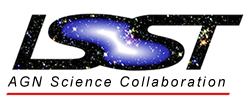Meetings
The 2025 July meeting of the LSST AGN Science Collaboration will be hosted in Durham, UK, from Monday 14th to Thursday 17th July.
See this page for full details.
The 2024 July meeting of the LSST AGN Science Collaboration was hosted by the Planetario di Torino “Attilio Ferrari” in Turin, Italy.
Details of the 2024 meeting are in this link.
The 2023 July meeting of the LSST AGN Science Collaboration was hosted by the National Radio Astronomy Observatory in Charlottesville, Virginia, USA.
Details of the 2023 meeting are in this link.
The 2022 July meeting of the LSST AGN Science Collaboration was held online, with the program as described below:
Supermassive Black Hole Studies with the Legacy Survey of Space and Time - 2022: Getting Ready for Rubin Operations
The 2022 Summer Meeting of the LSST Active Galactic Nuclei Science Collaboration: July 26-28, 2022
Supermassive Black Hole Studies with the Legacy Survey of Space and Time (LSST)
A Meeting-in-a-Meeting (MiM) as part of the 236th Meeting of the AAS
June 1-3, 2020
The Legacy Survey of Space and Time (LSST), to be conducted at the Vera Rubin Observatory beginning in 2023, will enable studies of the growing supermassive black holes (SMBHs) in active galactic nuclei (AGNs) on a truly massive scale. The tens of millions of AGNs discovered will be used for powerful studies of, e.g., the AGN luminosity function, AGN growth across varied cosmic environments, the highest redshift AGNs, AGN variability of many types, and transient SMBH fueling events. The LSST AGN Science Collaboration, currently composed of about 50 members spanning the globe, will lead many investigations of AGNs with LSST and supporting multiwavelength data. The time to prepare for AGN science with the petabyte deluge of LSST data is now, and this Meeting-in-a-Meeting (MiM) aims to stimulate such preparation.
Specifically, this MiM has the following main goals: (1) Provide outreach to the broad AAS membership, so that additional astronomers with interest can learn about the AGN science opportunities with LSST and consider joining the AGN Science Collaboration; (2) Allow in-depth presentation and critical discussion of exciting planned LSST and related AGN science projects; (3) Enable practical planning, coordination, and resource preparation so that these science projects can be executed successfully; and (4) Allow discussion and assessment of the currently evolving LSST observing strategy (e.g., cadence, total depth, footprints), so that key feedback can be provided to the LSST Project.
The MiM program will include 16 talks, each of 30 min duration including time for questions/discussion. The program will begin with a brief review of the LSST Science Collaborations and the LSST AGN Science Collaboration, including its ongoing activities and future plans. This will be followed by talks on AGN selection and characterization using LSST and supporting data, including the science that will be performed with the massive resulting AGN samples. There will then be talks on AGN variability studies using LSST data, including general variability characterization, transient SMBH phenomena, reverberation mapping, and changing-look AGNs. A forward-looking summary, discussion session, and potential hack session will conclude the MiM. In addition to the official allocated sessions, we aim to have several group lunches during the AAS meeting that will enable further discussions and planning.
The MiM schedule is available.
For questions or additional information, please email W. Niel Brandt (wnbrandt@gmail.com).
Video recordings of the six MiM sessions are available on YouTube...
Session 1: https://www.youtube.com/watch?v=vbROQY_88L0
Session 2: https://www.youtube.com/watch?v=TvSNrO-voa4
Session 3: https://www.youtube.com/watch?v=qjq0S23Pp6A
Session 4: https://www.youtube.com/watch?v=3ZFhdX2j2es
Session 5: https://www.youtube.com/watch?v=mhCdleBWEus
Session 6: https://www.youtube.com/watch?v=z9wb9bWLfWo
Slides for all the talks can be downloaded at https://www.dropbox.com/s/pzgmumkodg45tfb/2020-06-LSST-MiM-slides01.tar....
LSST AGN Science Collaboration Session at the LSST 2018 Project and Community Workshop
Thursday, August 16, 2018, 11:00 AM - 12:30 PM; Joshua Tree Room (El Conquistador Hilton Resort)
Meeting Program
Jan-Torge Schindler, University of Arizona
Franz Bauer, Pontificia Universidad Catolica de Chile
LSST AGN Science Collaboration Roadmap Development Meeting
An Open Splinter Meeting as part of the
229th AAS Meeting, Grapevine, TX
Tuesday, January 3, 2017, 9:00 AM - 6:00 PM; Appaloosa 2 (Gaylord Texan Resort & Convention Center)
Organizing Committee:
Organizing committee members may be contacted with any questions.
Meeting Program
Session 1: 9:00 - 10:30
Chair: Ohad Shemmer, University of North Texas
Coffee Break: 10:30 - 11:00 Group Photo
Session 2: 11:00 - 12:30
Chair: Niel Brandt, The Pennsylvania State University
Lunch Break: 12:30 - 1:30
Session 3: 1:30 - 3:00
Chair: Ohad Shemmer, University of North Texas
White Paper Posting
Coffee Break: 3:00 - 3:30
Session 4: 3:30 - 6:00
Chair: Gordon Richards, Drexel University
This meeting is kindly supported by the LSST Corporation
